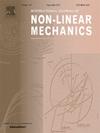Dynamical transitions between periodicity, quasiperiodicity, and chaos drive performance changes in a hybrid galloping energy harvester
IF 3.2
3区 工程技术
Q2 MECHANICS
International Journal of Non-Linear Mechanics
Pub Date : 2025-09-22
DOI:10.1016/j.ijnonlinmec.2025.105267
引用次数: 0
Abstract
This research investigates the relationship between complex dynamical transitions and average output power (AOP) in a hybrid galloping energy harvester (HGEH) featuring a vertically aligned D-shaped bluff body. The model of the HGEH is developed using Hamilton's principle. Based on the derived equations, the nonlinear dynamical behaviors and AOP variations are systematically analyzed with respect to four parameters associated with base excitation and wind energy. Nine distinct patterns of dynamical transitions between periodicity, quasiperiodicity, and chaos are identified, playing a crucial role in inducing jumps in periodic frequencies. Between two transitions, the HGEH remains in periodic vibration with a stable frequency over a broad parameter range, determining an upper limit for AOP growth. In most cases, the occurrence of quasiperiodic and/or chaotic vibrations in transitional regions causes abrupt, often opposing shifts or zigzags in the AOP curve. As a result, while the overall trend of the AOP curve shows a rise with varying parameters, the emergence of dynamical transitions makes the curve go like “resting between climbing stairs”. Furthermore, when wind speed varies, the maximum AOP is frequently achieved at peak points corresponding to period-3 vibrations. This study may provide valuable insights for optimizing HGEHs with D-shaped bluff bodies to enhance broadband concurrent energy harvesting.
周期性、准周期性和混沌之间的动态转换驱动混合驰骋能量采集器的性能变化
本文研究了一种具有垂直排列d型钝体的混合能量收集器(HGEH)的复杂动力跃变与平均输出功率(AOP)的关系。HGEH的模型是利用汉密尔顿原理建立的。在导出方程的基础上,系统地分析了与基础激励和风能有关的四个参数的非线性动力学行为和AOP变化。确定了周期性、准周期性和混沌之间的九种不同的动态转换模式,它们在诱导周期频率的跳跃中起着至关重要的作用。在两个转变之间,HGEH在一个很宽的参数范围内保持稳定频率的周期性振动,这决定了AOP生长的上限。在大多数情况下,准周期和/或混沌振动在过渡区域的发生会导致AOP曲线的突然的、通常相反的移动或之字形。因此,虽然随着参数的变化,AOP曲线的总体趋势呈现上升趋势,但动态过渡的出现使曲线像“在爬楼梯之间休息”。此外,当风速变化时,最大AOP往往在3周期振动对应的峰值点上实现。该研究为优化d型钝体hgeh以增强宽带同步能量收集提供了有价值的见解。
本文章由计算机程序翻译,如有差异,请以英文原文为准。
求助全文
约1分钟内获得全文
求助全文
来源期刊
CiteScore
5.50
自引率
9.40%
发文量
192
审稿时长
67 days
期刊介绍:
The International Journal of Non-Linear Mechanics provides a specific medium for dissemination of high-quality research results in the various areas of theoretical, applied, and experimental mechanics of solids, fluids, structures, and systems where the phenomena are inherently non-linear.
The journal brings together original results in non-linear problems in elasticity, plasticity, dynamics, vibrations, wave-propagation, rheology, fluid-structure interaction systems, stability, biomechanics, micro- and nano-structures, materials, metamaterials, and in other diverse areas.
Papers may be analytical, computational or experimental in nature. Treatments of non-linear differential equations wherein solutions and properties of solutions are emphasized but physical aspects are not adequately relevant, will not be considered for possible publication. Both deterministic and stochastic approaches are fostered. Contributions pertaining to both established and emerging fields are encouraged.

 求助内容:
求助内容: 应助结果提醒方式:
应助结果提醒方式:


